Your ECG Interpretation Practice Guide: How I Learned to Read ECGs Better than a Cardiologist

ECGs…EKGs…whatever you call them, I left medical school with a poor understanding of them. I could determine the rate, rhythm, and axis, and maybe a “tombstone” STEMI, but that was about it. During the first week of residency at NYU/Bellevue, I became even more insecure when one of my co-residents, Stephen Hoge, had an expert-like ability to read ECGs. I asked him how he became so comfortable reading them, and he mentioned he took a course with Dr. Tom Evans at UCSF and was provided Dr. Evans’s famous cribsheets. So, I started reading the cribsheets. It helped but still didn’t provide the foundation I needed. But then it happened…I found my path.
First off, you have an advantage that I didn’t have when it comes to ECG interpretation practice: the availability of the Clinical ECG Qbank. This Qbank teaches and tests the most important concepts of ECG interpretation for life-threatening issues encountered in acute care medicine. Check it out.
But before the Qbank existed, I relied on books for my ECG interpretation practice. Here’s the path I took:
1. I purchased ECGs for the Emergency Physician 1 by Amal Mattu and William Brady.
How I used the book:
- Look at ECG with clinical scenario
- Mentally note what is happening in the ECG (i.e., what is the rate and rhythm, any ST changes, how do the T waves look)
- Turn to the back of the book and read the ECG interpretation paragraph
- Take the main points from the ECG interpretation and add these notes to the initial ECG
- Review 5–10 ECGs per day. At the start of each day, I’d go back and review the notes I added to the ECGs
My ECG interpretation practice schedule looked something like this:
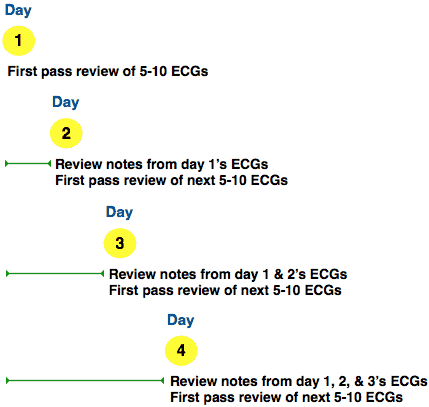
In the beginning I knew very little. My mental notes were limited. However, as the days went by, my knowledge began to increase and I recognized more and more characteristics in each ECG.
Here is an example of an ECG interpretation characteristic of Wellens’ sign. I took an initial first pass and reviewed the ECG. I made a mental note of characteristics such as biphasic T waves, Q waves, and flipped T waves. I then turned to the back of the book and reviewed the ECG interpretation.

Next I returned to the original, unmarked ECG and added my notes onto the ECG specifically identifying the characteristic findings.
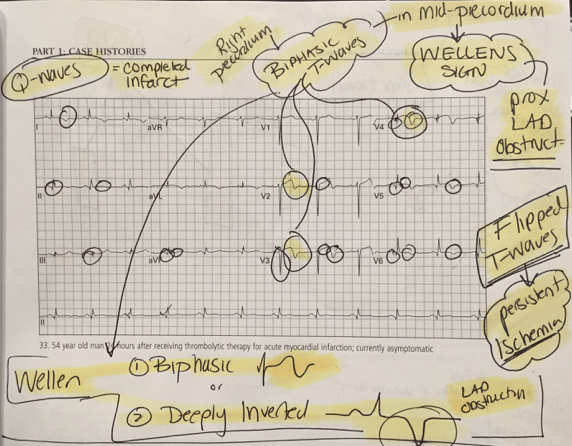
It is important to get through all 200 ECGs in this book as part of your ECG interpretation practice. At 5–10 ECGs per day and a few days off throughout your review, this will take about 1–2 months. Reviewing ECGs for the Emergency Physician 1 by Amal Mattu and William Brady served as the foundation for what lay ahead.
2. On to the next ECG book, which I believe is the most effective ECG learning book ever published: 12-Lead ECG: The Art of Interpretation by Tomas Garcia and Neil Holtz
How I used the book:
Start on page 1. Some of the content may seem elementary, but understanding the “why” and “how” of ECGs is important for mastery. Think about the first 70 pages (part 1) being a much clearer version of what Dubin’s book was trying to teach.
Part 2 is where you’ll find the gold when it comes to ECG interpretation practice. Read it like a book and be deliberate. Take what is being described in the text and identify the characteristics in the ECG. Circle the abnormalities, write notes on the ECG.
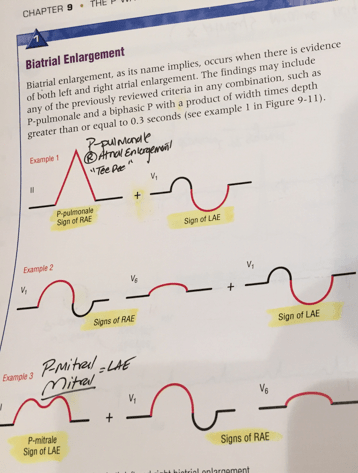
Taking what the text is describing, identify these findings in the subsequent ECG.
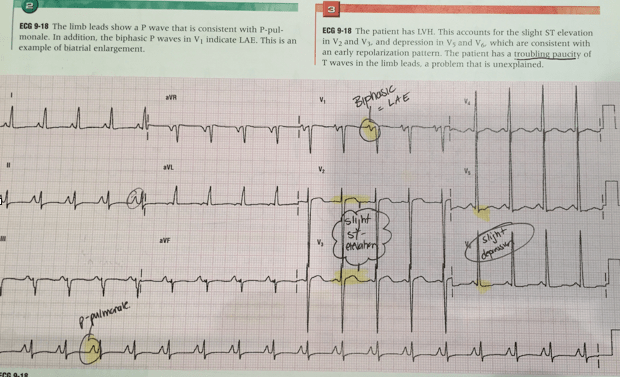
In addition to reading through each section and taking notes on the ECGs, also begin to create notecards. Yes…notecards are great for ECG interpretation practice.
There are two kinds of notecards. Type 1 is simply taking an important point and writing it on the front of the notecard. Nothing on the back. No flipping.
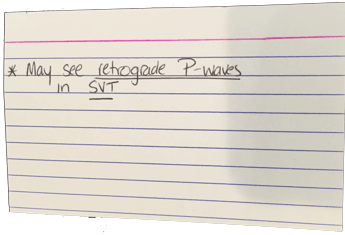
For Type 2 notecards, a statement or question is written on the front and an answer or explanation is written on the back. These are meant to be flipped.
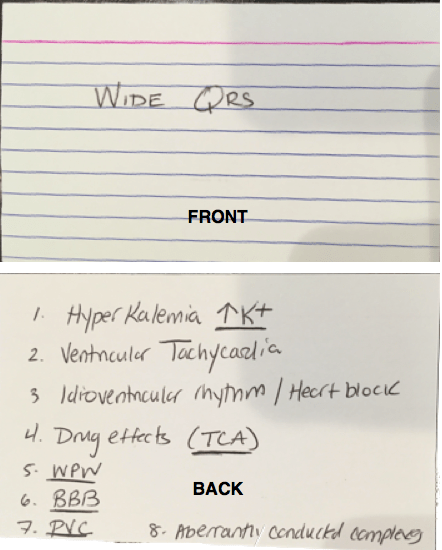
12-Lead ECG: The Art of Interpretation by Tomas Garcia and Neil Holtz is a thick book, dense with information…but it is presented in such a simplified way that ECG interpretation practice becomes fun. Yes, fun. How? Because the knowledge you are gaining is practical. During your next shift in the emergency department or rounding on floors, you are going to recognize more and more of what you are learning every day. Your confidence is going to increase. Soon, you will be eager to explain to your colleagues ECG findings that they are unfamiliar with. Soon, you’ll want to be called on during conference when an ECG is put on display and someone has to interpret it.
But this course is not over yet if you want to truly be confident at ECG interpretation.
Identifying a STEMI is going to be routine for you. Recognizing Wellens’ or Brugada is going to second nature. The remaining area to master is rhythm interpretation. In my experience, most ECG discussions—where the ECG gets passed around from one person to another—is when a rhythm is trying to be identified. “It’s second-degree type 2….no, it’s complete heart block.” Sound familiar?
3. Arrhythmia Recognition: The Art of Interpretation by Tomas Garcia and Geoffrey Miller
How I used the book:
Set up in the same way of Garcia’s first book (12-Lead ECG: The Art of Interpretation), Arrhythmia Recognition: The Art of Interpretation begins with an introduction to arrhythmia recognition then spends six sections diving into the different dysrhythmias. The book is also filled with excellent pearls.
Ever heard of Ashman’s phenomenon?
I hadn’t…but now I ask residents about it every time we see a patient with atrial fibrillation. Look for it yourself on an ECG or cardiac monitor of a patient with atrial fibrillation…I bet you’ll see it.
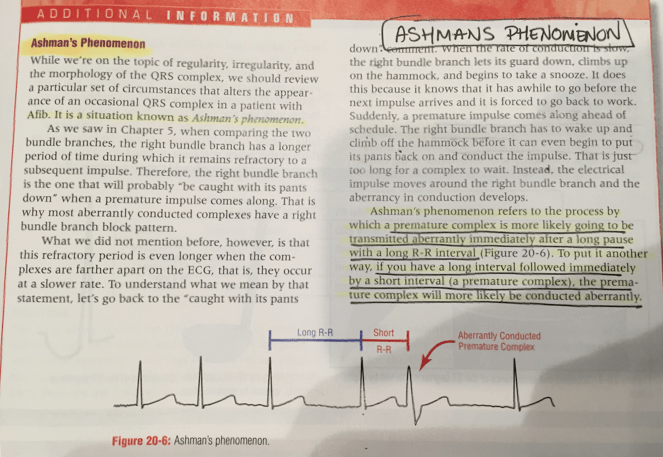
Approach this book in much the same way to get some good ECG interpretation practice. Take what is being described in the text and identify the characteristics in the ECG. Circle the abnormalities, write notes on the ECG. However, at the end of each section is a useful self-test. Do them.
The book also contains an assortment of useful tables and graphs to help categorize various ECG characteristics.
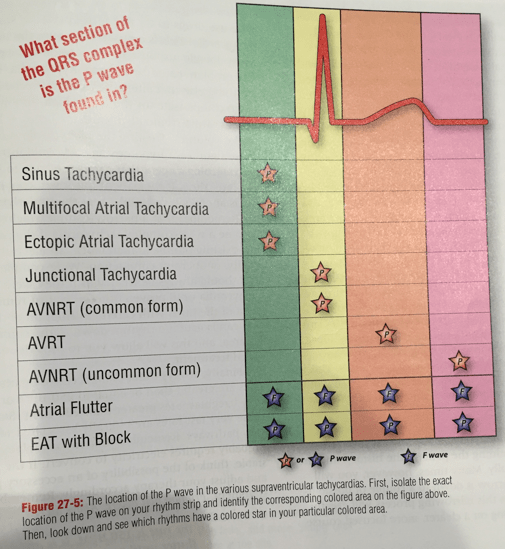
Arrhythmia Recognition: The Art of Interpretation is a beast…but it is a must to get through if you really want some good ECG interpretation practice. If you spend 10–20 min per day on it, you’ll need about 2–3 months to truly understand its teachings. But this is the last part for building your foundation and if you do not spend the necessary time on it, you’ll have a weak foundation. You don’t want a weak foundation, do you?
So far, we’ve discussed the 3 most important books when it comes to ECG interpretation practice:
- ECGs for the Emergency Physician 1 by Amal Mattu and William Brady
- 12-Lead ECG: The Art of Interpretation by Tomas Garcia and Neil Holtz
- Arrhythmia Recognition: The Art of Interpretation by Tomas Garcia and Geoffrey Miller
You now have a strong foundation. Most likely stronger than 95% of your colleagues. So how do we get to be in the 99th percentile?
Remember all the way back to when you started—looking at ECGs and struggling to characterize them? Well, it’s time to go back to the beginning…with a twist.
4. ECGs for the Emergency Physician 2 by Amal Mattu and William Brady
This is the second book in the series by Mattu and Brady and it’s just as good as their first book.
Go through the book in the same way as you did for their first book:
- Look at ECG with clinical scenario
- Mentally note what is happening in the ECG (i.e., what is the rate and rhythm, any ST changes, how do the T waves look)
- Turn to the back of the book and read the ECG interpretation paragraph
- Take the main points from the explanation and add these notes to the initial ECG
- Review 5–10 ECGs per day. At the start of each day, go back and review the notes added to the ECGs.
However, this time you are going to have much more knowledge and understanding of what is going on in each ECG. For some of you this may seem too easy! But don’t skip this exercise. It is serving to solidify what you already know and fill in the gaps for your weaker areas. You’re going to forget some of what you learned in the earlier reading…but this is an important part of your ECG interpretation practice. Forgetting ultimately leads to a better understanding. The harder you work to retrieve forgotten information, the more solidified it becomes in your long-term memory.
For those of you who aim for the 99.9%
You can stop now and you will have an understanding of ECGs that will last your entire career. You will be able to glance at an ECG and make an accurate diagnosis. You will be confident and if you desire, can establish yourself as the “ECG wizard” of your class, department, or practice.
But there’s more…
The last exercise is to use your expert ECG interpretation in a clinical context using the American College of Emergency Physicians (ACEP) book Electrocardiography in Emergency Medicine. This is an excellent resource by Amal Mattu, Robert Barish, and Jeffrey Tabas. Some of the contributors include Michael Bond, Gus Garmel, Andrew Perron, Ghazala Sharieff, and Stuart Swadron. In the preface they state the book is geared toward clinicians who “evaluate ECGs in real time and make decisions based on those assessments.” With the goal to provide an “easily understood, highly visual resource that is readable from cover to cover.”
The last habit to create is to follow up the ECGs that you interpret while working clinically. Often, a patient is admitted for a dysrhythmia and ends up on the medical floors or intensive care unit. The initial ECG obtained in the emergency department should also be read by a cardiologist and documented on the ECG or in the patient’s chart. Even better, some patients end up in the electrophysiology lab. Follow them up. Find out how other people interpreted their ECGs. This habit—the follow-up—is the fastest, least expensive way to get additional ECG interpretation practice and become an expert. Find out when you are right and learn from when you were wrong.
Good luck,
Adam Rosh, MD
Founder of Rosh Review
P.S. If you’re also interested in learning ECG interpretation based on both single-concept and case-based questions from an online Qbank, take a look at the Clinical ECG Qbank.
None of the book links above are affiliate links. They are pure recommendations.
Get Free Access and Join Thousands of Happy Learners
You must be logged in to post a comment.





Comments (0)